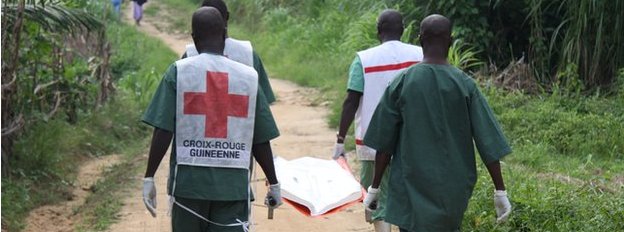No sooner had the World Health Organisation (WHO) elated Nigerians with the news that their government and that of Senegal had significantly contained the Ebola outbreak than it projected that 1.4 million cases could be recorded in Africa by mid-January, 2015, writes TEMITOPE DAVID-ADEGBOYE.
 Infections from the Ebola epidemic in Liberia and Sierra Leone could soar to 1.4 million cases by mid-January, 2014, unless the global community mounts a rapid response to the West African crisis, according to estimates released on Tuesday by the United States Centers for Disease Control and Prevention (CDC).
Infections from the Ebola epidemic in Liberia and Sierra Leone could soar to 1.4 million cases by mid-January, 2014, unless the global community mounts a rapid response to the West African crisis, according to estimates released on Tuesday by the United States Centers for Disease Control and Prevention (CDC).
Source of projection
This projection is based on a new CDC model that assumes that people are being infected with Ebola at a geometrically increasing rate, and that there are 2.5 times more cases than are being reported, the centre said in its new report.
However, this worst-case scenario may be averted, given the international relief response to the epidemic during the past month, CDC Director, Dr. Tom Frieden, said during a morning news conference.
The reported projections are based on numbers from the end of August, and since then the U.S. and other nations have stepped up their relief efforts.
“One of the things that have been so striking is how fluid things have been on the ground,” Frieden said. “Even a week or two ago, I would have expected things to look differently than they do now.”
Infections and deaths
Ebola cases in West Africa currently have reached an estimated 5,800 infections in people and more than 2,800 deaths, according to WHO.
The new CDC model specifically focuses on the value of isolating Ebola patients to prevent spread of the deadly virus. The agency found that till now, total Ebola cases are doubling approximately every 20 days in the two countries because people with the virus are coming into contact with healthy people and infecting them.
If seven out of 10 Ebola patients were isolated in their homes or a treatment centre, the epidemic in both Liberia and Sierra Leone could be broken by mid-January – a drastically different projection than the worst-case scenario, officials said.
“If you get enough people effectively isolated, the epidemic can be stopped,” Frieden said. “Related to that, when you reach a higher enough number, the number of cases plummets rapidly, almost as rapidly as the exponential rise we’re seeing now.”
Resources from U.S.
The CDC, the Department of Defense and the United States Agency for International Development (USAID) are all pouring human and material resources into West Africa, joined by efforts from the United Nations and other countries, said Gayle Smith, Special Assistant to President Barack Obama and Senior Director of the National Security Council.
“We think these things that were not fully in play are things that can contribute to bending the (epidemic’s) curve,” Smith said.
International relief
International relief efforts have been increased in recent weeks, but the virus continues to spread. Part of the problem: there aren’t enough hospital beds, health workers or even soap and water in the hardest-hit countries of Guinea, Liberia and Sierra Leone, the Associated Press reported.
“Ebola outbreaks usually end when people stop touching the sick,” said Dr. Armand Sprecher, an infectious diseases specialist at Doctors without Borders. “The outbreak is not going to end tomorrow, but there are things we can do to reduce the case count.”
Local health officials have launched campaigns to teach people about the symptoms of Ebola and not to touch the sick or the dead, the AP added.
Ebola-free Nigeria?
Meanwhile, Nigeria’s Health Minister, Onyebuchi Chukwu, reports that Nigeria is completely free of active Ebola cases and has released the final victim’s contacts from surveillance.
In a telephone interview, the Minister of Health said: “Presently, there is no single case of Ebola virus disease in Nigeria – none.”
Dr. Chukwu provided further details.
His words: “No cases are under treatment, no suspected cases. There are no contacts in Lagos that are still under surveillance, having completed a minimum of 21 days of observation.”
In the process of tracing contacts of individuals infected with Ebola, anyone showing no symptoms after three weeks of last known contact with a victim is considered free of any potential for the disease.
Rivers State had been home to over 400 contacts under medical surveillance. Recently, only 25 contacts remained.
None of them showed any symptom on Monday, September 22, which marked the end of their 21 days of observation.
Recently, the U.S. said it would build more than a dozen medical centres in Liberia and send 3,000 troops to help. Liberia has been hit especially hard by the epidemic.
Great Britain and France have also pledged to build treatment centres in Sierra Leone and Guinea, and the World Bank and United Nations Children’s Fund (UNICEF) have sent more than $1 million worth of supplies to the region, the news service said.
“We’re beginning to see some signs in the response that gives us hope that increase in cases won’t happen,” said Christopher Dye, WHO’s director of strategy and co-author of a study published online on September 23 in the New England Journal of Medicine, which acknowledged the predictions come with a lot of uncertainties.
Some infectious disease experts agreed that the worst-case scenarios could be overblown, and the back of the Ebola outbreak would be broken by changes in people’s behaviour, the AP reported.
• Additional materials from webmd.com, Forbes.com













